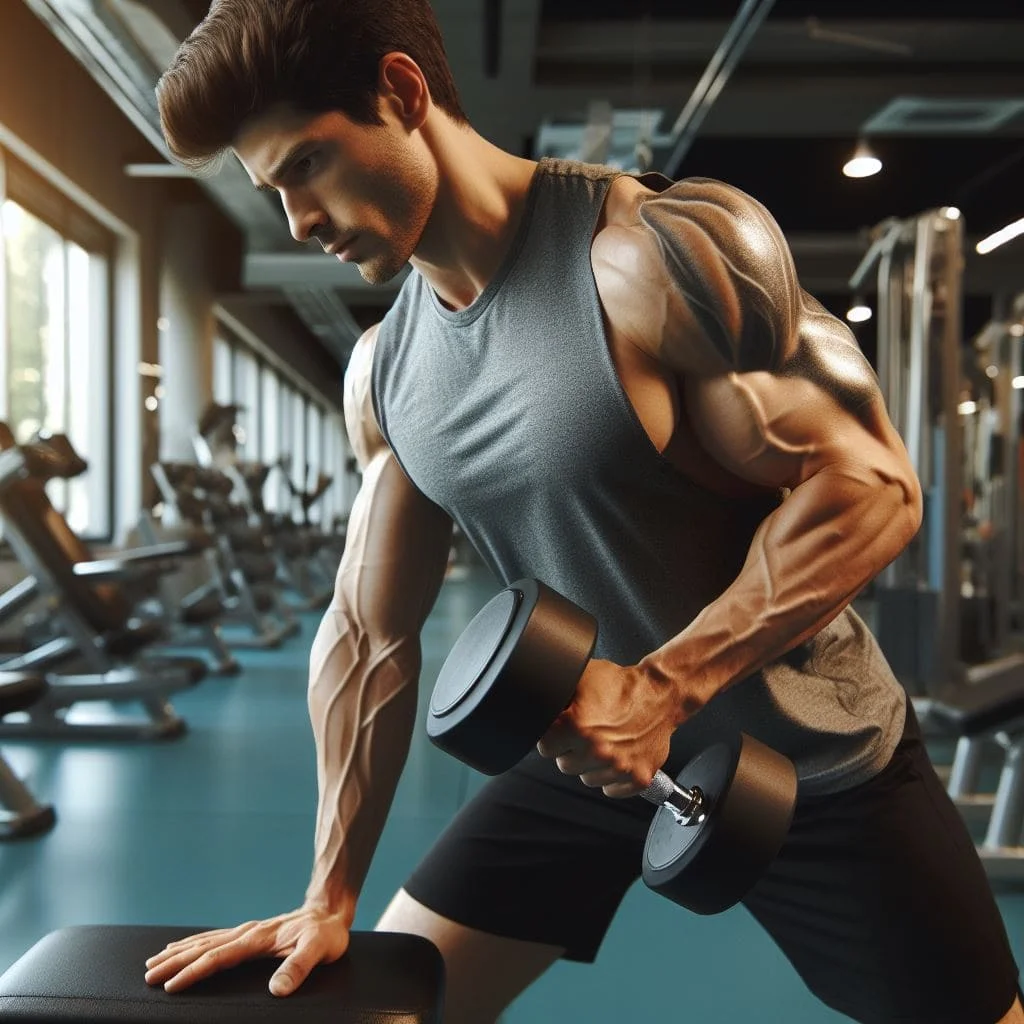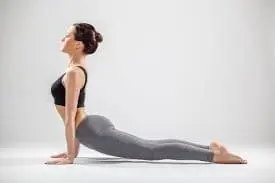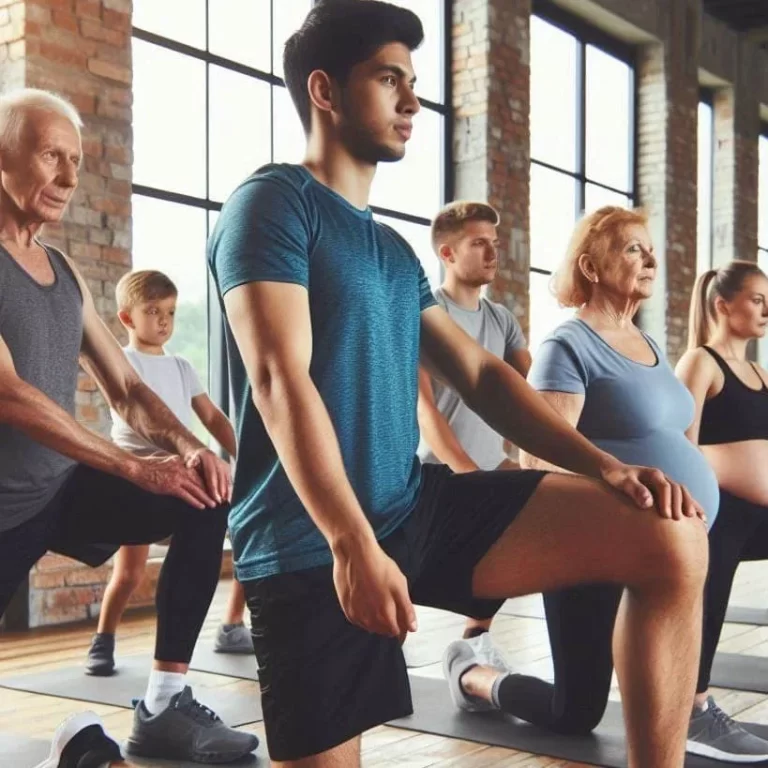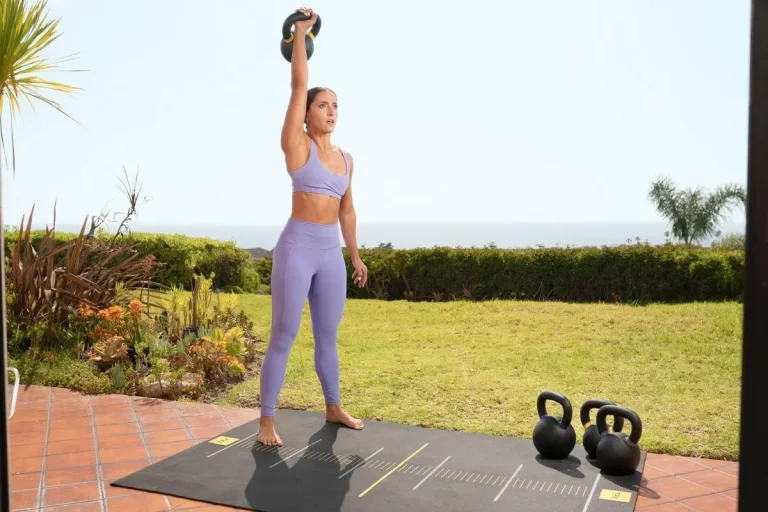38 Best Brachioradialis Muscle Exercises
Brachioradialis muscle exercises are essential for improving forearm strength, enhancing grip endurance, and supporting overall arm functionality.
Strengthening this muscle not only aids in everyday tasks but also contributes to better performance in various sports and physical activities where a strong and stable forearm is advantageous.
Additionally, a well-developed brachioradialis can add to the aesthetic appearance of the arm, providing a balanced and muscular look.
What is the brachioradialis?
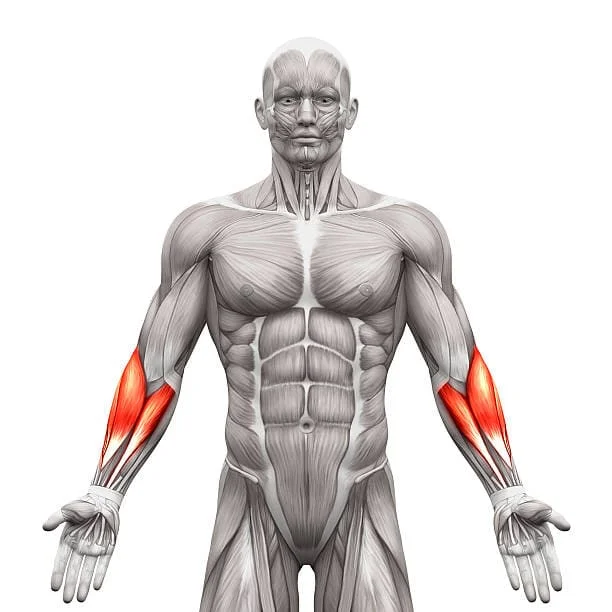
The strongest and most prominent muscle in your forearms is the brachioradialis. It extends from your wrist’s beginning to the beginning of your upper arm.
Although multiple forearm muscles combine to carry out different tasks, elbow flexion is mostly accomplished by the brachioradialis.
You must use exercises that specifically target the brachioradialis if you want to strengthen your forearms.
Understanding of the Brachioradialis:
The lateral supracondylar ridge of the humerus is the source of the brachioradialis muscle, which inserts into the distal radius. Its main purpose is to flex the forearm at the elbow, particularly during hammer curls or other exercises where the forearm is in a neutral position (thumbs up). It is a flexible muscle that may be used for a variety of grips and activities because it also helps with forearm pronation and supination.
Functions of the brachioradialis muscle:
The brachioradialis muscle assists in stabilising the wrist joint during specific activities, such as lifting or tugging objects, in addition to allowing the elbow to bend.
It is most active when the arm is required to be in a semi-pronated position, which is when the hand’s palm is angled downward.
When the forearm is rotated so that the palm faces downward, a condition known as pronation, the brachioradialis muscle can help.
As the brachioradialis muscle joins the radius bone in the forearm and crosses the elbow joint, it can also function as a secondary flexor of the wrist joint.
The brachioradialis muscle is a crucial forearm muscle that serves multiple vital purposes.
- Elbow Flexion: The brachioradialis muscle’s main job is to flex the forearm at the elbow joint. The brachioradialis aids in the movement that occurs when you bring your hand to your shoulder, as in a bicep curl.
- Forearm Supination and Pronation: Although it is not the main muscle involved in forearm rotation, the brachioradialis does play a role in supination, or moving the palm upward, and pronation, or rotating the palm downward, to some extent, especially when the elbow is flexed.
- Elbow Joint Stabilization: During a variety of forearm-related motions, the brachioradialis assists in maintaining the elbow joint’s stability. When lifting and transporting goods, for example, this stabilization is essential to preserving correct alignment and avoiding overstressing the joint.
- Grip Strength: The brachioradialis helps with wrist extension and flexion, which indirectly enhances grip strength even though it is not directly responsible for it. A stronger brachioradialis can improve wrist and hand stability and support, strengthening the grip during tasks requiring holding or grasping objects.
- Assistance in Fine Motor Movements: The brachioradialis is involved in fine motor movements of the hand and fingers, especially when they include wrist extension or flexion, even though it is mainly involved in bigger, more dynamic motions of the forearm.
This indicates that it can help bend the wrist in the palm’s direction or downward.
Generally speaking, the brachioradialis muscle’s job is to produce movement and offer stability when performing a range of arm and forearm motions, such as grasping, raising, tugging, and turning the forearm.
Benefits of brachioradialis exercise:
There are various advantages to brachioradialis muscle exercise:
- Enhanced Arm Function: The brachioradialis is important for forearm pronation and supination, as well as elbow flexion. By strengthening this muscle, you can improve the effectiveness of your arms overall and make daily tasks like gripping, lifting, and carrying goods easier.
- Increased Grip Power: Strengthening the brachioradialis can help with wrist flexion and extension, which in turn can enhance grip strength. Those who exercise, are athletes, or work physically will find this especially helpful.
- Decreased Risk of Injury: By stabilising the elbow joint, strengthening the brachioradialis helps lower the risk of overuse injuries, sprains, and strains—particularly while engaging in repetitive arm movement exercises.
- Balanced Arm Development: A lot of arm workouts concentrate mostly on the triceps and biceps, which may cause muscular imbalances. Exercises targeting the brachioradialis guarantee more balanced arm muscle growth, which is critical for overall strength and stability.
- Enhanced Athletic Performance: Robust brachioradialis muscles are advantageous for athletes, particularly those participating in activities like rock climbing, gymnastics, and martial arts. These muscles support a range of arm actions by providing strength, dexterity, and control.
- Functional Fitness: You can increase your functional fitness and your ability to carry out daily duties more easily and effectively by strengthening your brachioradialis muscle with exercises like hammer curls and reverse curls.
- Tennis Elbow Prevention: By giving the joint more support and stability, strengthening the muscles surrounding the elbow, particularly the brachioradialis, might help avoid disorders like tennis elbow (lateral epicondylitis).
- Improved Aesthetic Look: By providing definition and symmetry, well-developed brachioradialis muscles enhance the arms’ overall aesthetic look.
Strengthening the Brachioradialis: Essential Exercises for Forearm Power
One of the forearm’s most noticeable muscles, the brachioradialis, is essential for elbow flexion and for building total forearm strength. Training the brachioradialis can help you achieve a number of goals, including increased forearm muscle, improved functional fitness, and improved sports performance. The greatest workouts to work this important muscle will be covered in detail in this article.
Best Exercises for Building Brachioradialis Strength
Pronation of the forearm:
With the palm facing up, place the forearm on a table while gripping a small dumbbell in your hand.
Turn the palm over gently so that the bottom side is facing up.
Take 30 seconds to hold this position, then return to the starting position.
Five to ten times, repeat.
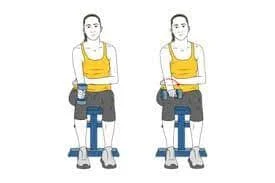
Supination of the forearm:
With the palm of your hand pointing downward, place your forearm on a table and grasp a small dumbbell.
Once the palm is facing up, turn it over.
Take 30 seconds to hold this position, then return to the starting position.
Five to ten times, repeat.
Stop moving the brachioradialis immediately and consult with the physical therapist if any movement produces pain.
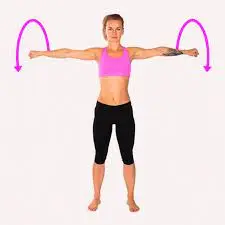
Arm Rotations:
How to Do It: Stand with your feet shoulder-width apart, then raise your arms to shoulder height in the sides.
Using your hands, create little circles that gradually get bigger.
Reverse the direction of the circles after 15 repetitions.
Advantages: Arm circles increase strength and flexibility by using the brachioradialis and other arm and shoulder muscles.
Dumbbell Forearm Rotation
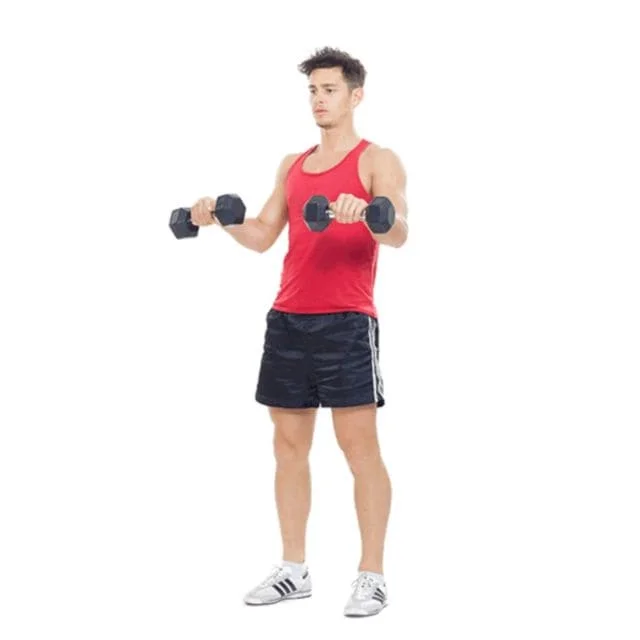
Keep your hands in a neutral position while holding a somewhat heavy dumbbell in each hand.
Maintain a straight stance while you rotate your wrists, first in a pronated and then a supinated position.
After 20–30 repetitions for one or two sets, aim for muscular failure.
Pull-Up with Close-Grip
Your delicate overhand grasp secures the pull-up bars.
Put your head forward and tighten your lats.
Squeeze your back muscles, bend your arms and keep your legs still while you pull your upper chest towards the bar.
Feel your arms extend as you return to your starting position.
Perform a set or two of six to twelve repetitions.
Barbell Curl in Reverse:
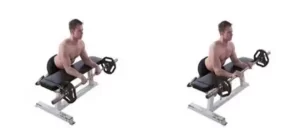
This brachioradialis workout, also called the overhand curl, works your biceps and forearms directly.
Setup: a) Hold a barbell with your palms pointing in your direction and your hands about shoulder width apart.
b) Stand up straight and tall, keeping your back straight.
Action: a) To curl the barbell upward, contract your biceps.
b) At the peak of the rep, firmly squeeze your biceps and slowly lower yourself back to the starting position.
c) Carry out this movement as many times as you like.
Dumbbell Hammer Curl:
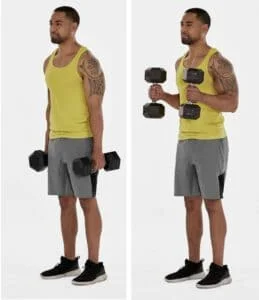
One of the most well-liked bicep curl varieties is the hammer curl. The brachioradialis is called upon by the hammer grip in order to maintain weight control during the movement.
Setup: a) With your hands facing each other, grab a pair of dumbbells.
b) Stand up straight and tall, keeping your back straight.
Action: a) To curl the dumbbells upward, flex your biceps and engage your core.
b) At the peak of the exercise, firmly contract your biceps and gradually bring the dumbbells back down to the beginning position.
c) Carry out this movement as many times as you like.
Rotations from the rear to the front
In order to flex your elbow at the end of each repetition in this dumbbell brachioradialis exercise, concentrate on squeezing your brachioradialis.
Setup: a) Hold a set of dumbbells with your hands pointing in the same direction. Grip the shafts by their very bottoms.
b) Take a strong stance and maintain your arms by your sides.
Action: a) Flex your wrists upward and raise the front end of the dumbbells by contracting your brachioradialis.
b) Firmly contract your brachioradialis and raise the dumbbells back to their initial position.
c) Continue for the required number of repetitions.
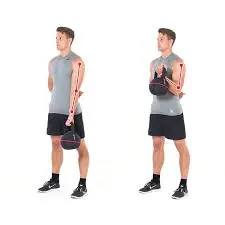
Kettlebell Reverse Curl with 1-Arm
With this brachioradialis workout, you may work on both arms at the same time.
Setup: a) With one hand, hold a kettlebell with your palm pointing in your direction.
b) Stand up straight and tall, keeping your back straight.
Action: a) To curl the kettlebell upwards, contract your bicep.
b) At the peak of the rep, firmly squeeze your biceps and slowly lower yourself back to the starting position.
c) Carry out this movement as many times as you like.
Hammer Curl Resistance Band
The banded hammer curl puts more strain on your brachioradialis as you curl upward.
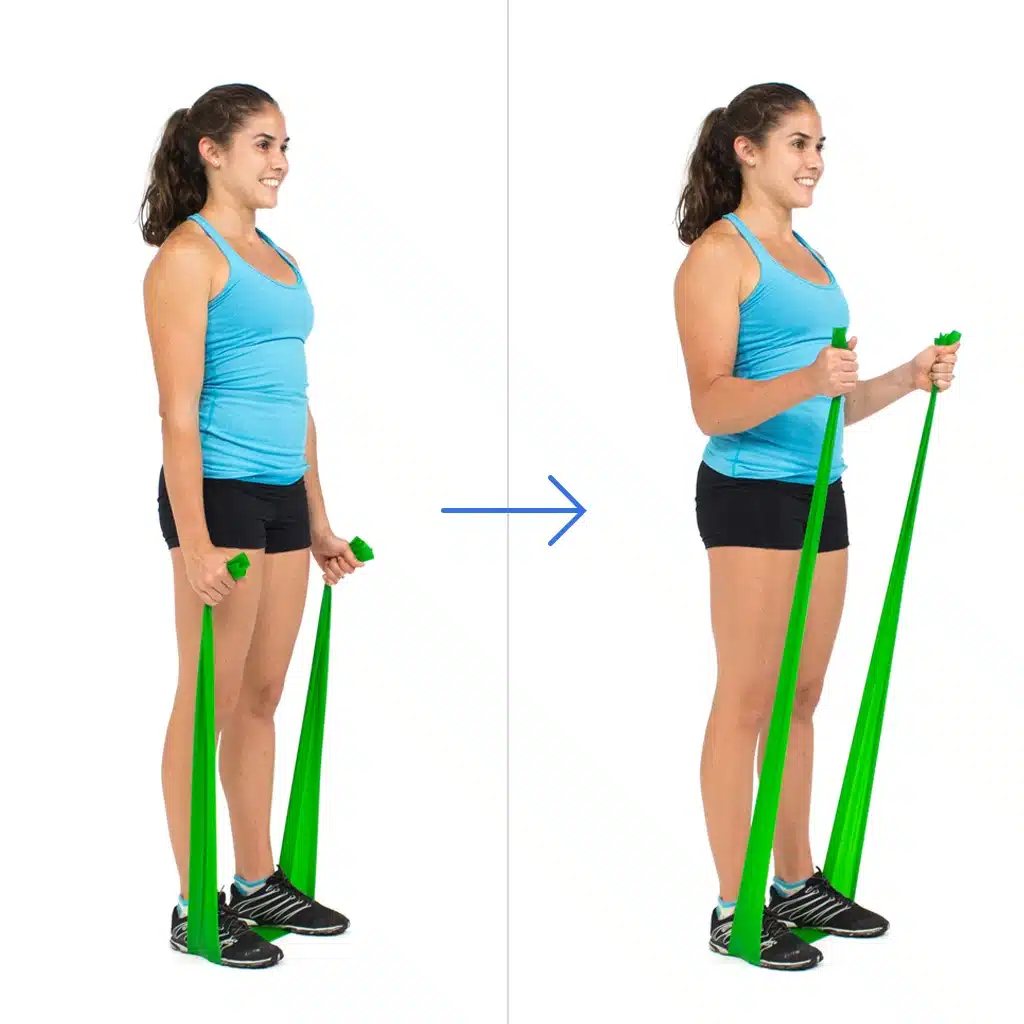
Setup: a) With your hands facing each other, grasp the ends of a resistance band, right below the handles.
b) With your back straight, take a strong standing position on the resistance band.
Action: a) Curl your hands upward by using your core and biceps to contract.
b) At the peak of the exercise, firmly contract your biceps and then gradually bring your hands back to the beginning position.
c) Carry out this movement as many times as you like.
Supination with resisted band
Start this workout by encircling the hand with a resistance band.
The elbow position should be sideways and at a 90-degree angle.
Turn your forearm slowly so that the palm is facing up against the resistance band.
Try to avoid pain as much as possible and complete three sets of ten repetitions.
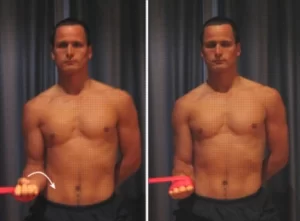
Pronation with resisted band
Start this workout by encircling the hand with a resistance band.
The elbow position should be sideways and at a 90-degree angle.
Turn your forearm slowly so that the palm is facing downward against the resistance band.
Try to avoid pain as much as possible and complete three sets of ten repetitions.
Grip Reverse EZ Bar Curls
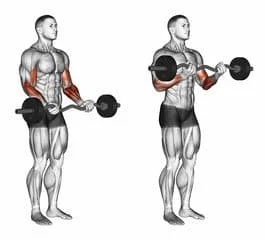
Place your feet and stand in a manner similar to the Cable Hammer Curl.
Hold onto the EZ-curl bar by facing down on the angled part of the bar, which is attached to the bottom of the cable.
Curl the bar up and down like you would with a typical bicep curl exercise.
When you perform the cable hammer curl, keep your elbow and shoulder stances firmly in place.
Repeat for 2-4 sets of 10–20 reps.
Hammer Curl with Cable
A well-known workout that targets the arms is the cable rope hammer curl, which involves using a rope or cable handle that is attached to a weight stack via a cable. It uses a neutral grip (palms facing each other) and works primarily the brachialis and forearm muscles, as well as the biceps.
How to Do a Hammer Curl With Cables
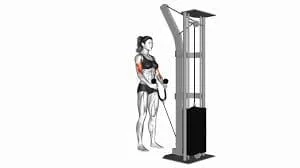
Position yourself facing the machine and fasten a cable attachment to a low pulley.
Using a neutral grip (palms in), grab hold of the rope.
For the duration of the exercise, position your elbows sideways and remain there.
Pull the arms till the forearms and biceps meet.
Hold on for a moment.
Start lowering the weight gradually to its starting position.
Repeat for the indicated number of repetitions.
Advice
Maintain the natural arch of your back and your torso while standing upright.
Recall to keep your upper arms still and your elbows tucked in.
Exercise should be done carefully to prevent momentum from influencing the movement.
Reverse Curl on Cable
A workout using a machine that targets the brachioradialis is the reverse cable curl. Nonetheless, one can experiment with a variety of reverse cable curl adjustments, some of which may call for specific kinds of reverse cable curl gear. Exercises for the brachioradialis must include this cable bicep exercise.
The Cable Reverse Curl: How to Do It
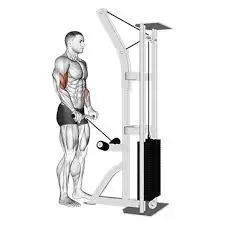
Start by standing upright and maintaining a straight posture while holding onto a bar attachment that is fastened to a low pulley with a pronated (palms down) and shoulder-width grip.
Keep your elbows bent and flex them to bring the bar to your chest.
Make a contraction and hold the position for a while.
Return the bar to the extended position by lowering it gently.
Repeat ten times.
Advice
The body needs to stay in place. The weight should only be moved using the biceps.
Squeeze your biceps after stopping at the peak of the movement.
Make sure your hands are firmly gripping the bar, your knees should be slightly bent, and your elbows should remain close to your sides.
Reverse Zottman Curl Dumbbell
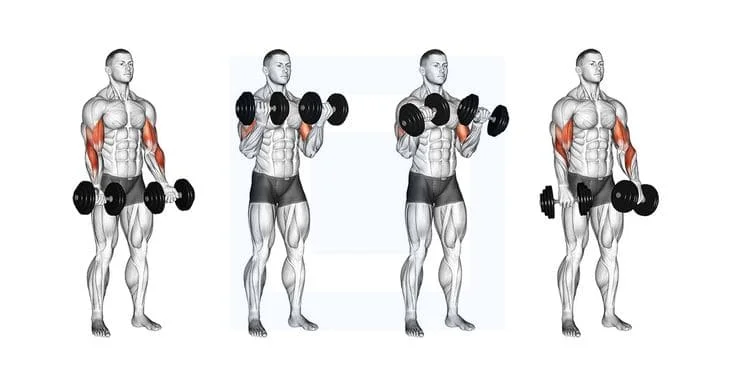
Along with several other forearm muscles, the brachioradialis is the focus of the reverse zottman curl.
Setup: a) Hold a pair of dumbbells in front of you with your palms facing up.
b) Take a stance and place your feet about hip-width apart.
Action: a) Curl the dumbbells upward by contracting your biceps while maintaining a straight back.
b) Twist your hands so that the palms face forward and firmly squeeze your biceps at the top.
c) Twist your hands to bring your palms back towards you after lowering the dumbbells to the beginning position slowly.
d) Carry out this movement as many times as you like.
Rear-front rotations:
The patient is grasping two dumbbells, their palms facing in the direction of one another.
Grip the shafts by their very bottoms.
The patient is standing up and keeping their arms by their sides.
To flex the wrist joint upward and raise the front end of the dumbbells, contract the brachioradialis muscle.
Firmly contract the brachioradialis muscle and raise the dumbbells back to their initial position.
Perform this exercise three times in a single session and two to three times a day.
Dumbbell Reverse Curl
A variation of the classic bicep curl in which the barbell is grasped palm-up is called the dumbbell reverse curl. It targets numerous forearm muscles, including the brachioradialis. The same movement is made, but by switching up the grip, particular arm muscles can be worked on.
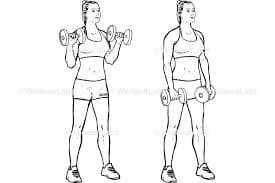
The Dumbbell Reverse Curl: How to Do It
To begin, maintain a straight posture and place your feet shoulder-width apart.
With your arms fully extended, take an overhand grip on a dumbbell in each hand.
Curl the weights up towards the shoulders while maintaining a straight back and fixed upper arms.
This movement requires only the forearms.
Dumbbells should be kept coiled until they reach shoulder height and the biceps are completely tensed.
Breathe in while the person makes a clean arc back to the starting position.
Advice
Gently rotate your forearms; too much force can strain your elbows or wrists.
In order to enhance tension and the mind-muscle connection, try performing the exercise with a gradual eccentric.
Throughout this workout, pay close attention to appropriate weight and body mechanics at all times.
Dumbbell Concentration Curl with Reverse-Grip
One of the best brachioradialis workouts is the reverse grip dumbbell concentration curl, which focuses on squeezing the brachioradialis to flex the elbow at the end of each repetition. It’s an isolation exercise that works the brachioradialis and brachii biceps.
The Dumbbell Reverse-Grip Concentration Curl: How to Do It
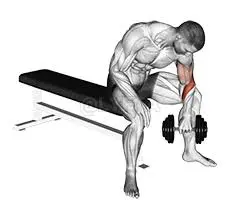
To begin, take a seat with your legs apart on a bench and hold a dumbbell in one hand.
Place the elbow against the inner of the left thigh when the arm is nearly completely extended.
Turn your wrist so that the palm is facing the back.
Breathe in while lowering the dumbbell to its starting position.
Use the other arm to perform the same movement.
Advice
At the bottom of the workout, do not lock out.
Maintain a straight back.
Hammer Preacher Curl using Dumbbells
A great workout that works the brachioradialis, brachialis, and biceps is the dumbbell hammer preacher curl. Focus more on the brachioradialis and brachialis than the biceps when using a hammer/neutral grip. It is the ideal alterations to the preacher’s curl.
How to Do the Hammer Preacher Curl With Dumbbells:
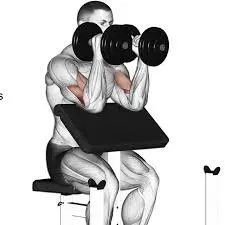
Arms should be level with the top of the preacher bench seat after adjusting the seat.
With both hands, take a neutral or hammer grip on a dumbbell, and rest your arm fully down against the bench.
As you perform the exercise, slowly curl the dumbbells up towards your head while keeping your arms resting on the bench until you reach the highest position.
Squeeze, hold, and isolate the biceps for a count.
Do the ten-number repetitions again.
Advice
To achieve the finest results, perform this exercise slowly and deliberately.
Avoid locking out your elbows to avoid tearing your biceps.
Preacher Curl Reverse Dumbbell
A variation on the normal preacher curl, the reverse preacher curl targets the brachialis muscle, which is located deeper in the upper arm than the biceps brachii. The wrist flexors contract to serve as stabilising muscles, while the brachialis and brachioradialis muscles help with elbow flexion.
How to Perform the Reverse Preacher Curl with Dumbbells
Arms should be level with the top of the preacher bench seat after adjusting the seat.
With both hands, take a pronated (palms down) hold on a dumbbell and lay your arm fully down against the bench.
As you slowly curl the dumbbells up towards your head, maintain your arms on the bench until you reach the highest position.
Squeeze, hold, and isolate the biceps for a count.
Do the ten repetitions again.
Advice
Make sure the person uses controlled repetition time and a gentle approach to the action.
At the conclusion of the reverse curl, avoid locking out your elbows, as this might tear your bicep and release tension in the muscle.
Use a lighter to moderate weight, if possible.
Chin-ups:
Along with several other upper body muscles, the brachioradialis muscle can be effectively worked out with chin-ups.
How to execute chin-ups:
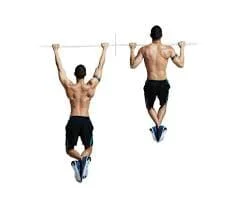
With your hands somewhat closer together than shoulder-width apart, hang from a chin-up bar using an underhand hold. Your body should be erect with your core activated, and your arms should be fully extended.
Bend your elbows and raise your chin above the bar to pull yourself up towards the bar. Throughout the exercise, keep your chest high and contract your back muscles.
With your arms extended to their maximum length, carefully return to the starting position.
Make sure to engage the brachioradialis and other upper body muscles as you repeat the movement for the necessary number of repetitions.
Incline curls:
Exercises like incline curls work the biceps brachii and activate the brachioradialis, a secondary muscle.
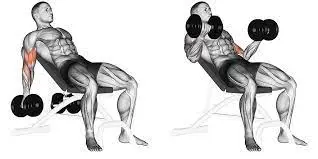
First, set an incline bench to a 45-degree angle in order to perform incline curls. Grasp a pair of dumbbells with an underhand grip, palms facing upward, while seated on the bench. With your feet flat on the ground, lean back on the bench and stretch your elbows fully, letting your arms dangle straight down towards the floor. Next, release the air and carefully curl the dumbbells towards your shoulders while maintaining the motionless position of your upper arms.
When you lift the weights, concentrate on tensing your brachioradialis and biceps. Squeeze your muscles and hold for a little while at the peak of the exercise.
Extend your elbows fully as you slowly lower the dumbbells back to the starting position. To properly target and strengthen the brachioradialis muscle, complete the required number of repetitions while maintaining correct form.
Wrist Curls (Palms facing up)
The brachioradialis muscle and other forearm flexors are targeted by wrist curls performed with the palms facing up.
To complete this task,
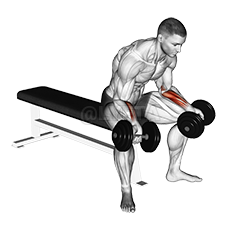
With your feet flat on the ground, take a seat on a bench or chair. With your palms facing up, hold an underhand grip dumbbell in each hand. Place your arms on your thighs so that your wrists cross your knees.
Exhale and flex your wrists towards your forearms to curl the dumbbells upward without raising your forearms off your thighs.
Squeeze your forearm muscles while holding the top position for a short while, then take a breath and gradually drop the dumbbells back down to the beginning position.
Execute the targeted quantity of reps while maintaining precise form and controlled motions.
By specifically working the brachioradialis and other forearm flexor muscles, this exercise helps increase grip strength and forearm endurance. Dumbbell weight should be adjusted based on your current level of strength. During the workout, pay attention to keeping the targeted muscles tense.
Reverse Wrist Curls (Palms facing down)
The brachioradialis muscle and other forearm extensors are the main targets of reverse wrist curls performed with the palms facing downward.
To complete this exercise:
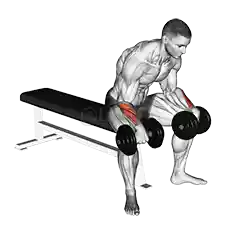
Place your feet flat on the ground while you sit on a chair or bench to begin. With your hands facing down and your arms resting on your thighs, raise your wrists over your knees to hold an overhand grip dumbbell in each hand.
Exhale and curl the dumbbells upward by extending your wrists, bringing them as close to your forearms as you can without lifting your forearms off your thighs. Keep your palms facing down and your forearms lying on your thighs.
Feel the contraction in your forearm extensor muscles as you hold the top position for a little while.
Breathe in, then gradually return the dumbbells to the beginning position so that your wrists can fully extend.
For the required number of repetitions, repeat the activity, paying close attention to controlled motions and keeping the targeted muscles tense throughout.
The brachioradialis muscle and other forearm extensors are successfully targeted by reverse wrist curls performed with the hands facing downward.
This workout enhances grip strength, wrist stability, and general forearm endurance. To get the most out of the exercise and optimise its effects, modify the weight of the dumbbells based on your current level of strength.
Farmer’s walk:
The brachioradialis and other upper body muscles, as well as the muscles of the lower body and core, are the main objectives of the easy-to-do yet powerful Farmer’s Walk exercise. The Farmer’s Walk can be executed as follows:
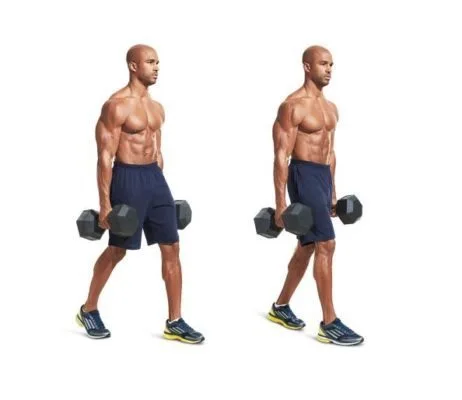
- Hold a dumbbell or kettlebell in each hand and take a tall stance. Select weights that are difficult but doable. The weight has to be substantial enough to offer resistance without causing you to lose form.
- Keep the kettlebells or dumbbells at your sides in a neutral hold, with your palms pointing inward.
- To keep your posture stable and erect, contract your core muscles. Throughout the exercise, maintain a neutral spine, chest up, and shoulders back and down.
- Start moving ahead deliberately, one rapid step at a time.
- Keep the weights towards your sides and your arms outstretched.
- When you walk, concentrate on keeping your body balanced, and try not to sway or lean too much. Maintain your head in line with your spine and your eyes forward.
- Depending on your goals and degree of fitness, you can walk a specified distance or for a predetermined length of time. As you gain strength and comfort with the workout, progressively increase the distances or periods you begin with.
- When the allotted time or distance has passed, carefully stop and return the weights to the starting position.
The farmer’s walk is a fantastic practical exercise that enhances grip strength, core stability, and general muscular endurance in addition to strengthening upper body muscles, particularly the brachioradialis.
Pushups using your fingers:
Bring your fingertips down to the surface while kneeling next to a bench or other stable object.
Bring your chest to the bench slowly and deliberately, bending your elbows to a 90-degree angle.
Go back to where you were before.
Perform 1-3 sets of 8–12 reps.
Try this exercise with your fingertips on the floor for added difficulty.
Behind-the-back cable curl:
One exercise that works the brachioradialis and biceps is the behind-the-back cable curl.
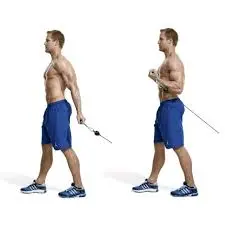
To execute it, face a cable machine that has a low pulley attached to a straight bar.
With your hands shoulder-width apart and your palms pointing back, take an overhand grip on the bar.
Take a step back to tighten the cable, then release your breath and bend your elbows to curl the bar upward.
Throughout the exercise, keep your elbows close to your sides and your upper arms still.
After a little period of time, carefully lower the bar back to the beginning position.
Execute the targeted quantity of reps while maintaining precise form and controlled motions.
The cable resistance in this exercise creates continuous strain on the brachioradialis and biceps, which can enhance arm strength and definition. To guarantee appropriate resistance, adjust the weight on the cable machine based on your level of strength.
Dead Hangs:
Dead hangs are a basic yet powerful exercise that works the core and grip strength in addition to the upper body muscles, such as the brachioradialis.
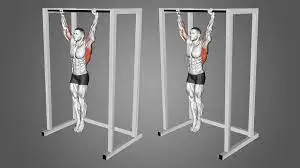
How to execute a dead hang:
- Look for a strong structure or overhead bar to swing from.
- To get to the bar, leap up or, if needed, use a step stool.
- Use either an alternate grip—one palm facing away from you, the other towards you—or an overhand grip to hold the bar. Slightly broader than shoulder-width apart is how your hands should be placed.
- Lean back and relax your shoulders while letting your body hang loosely from the bar. You should not put your feet on the floor.
- Keep your head and heels in a straight line and your core active. Avoid kicking and swinging your legs.
- For as long as you can, hold the position while concentrating on taking deep breaths and remaining calm.
- When you’re ready to stop, release the air and slowly return to the floor while keeping control of your descent.
The plank with shoulder taps:
It works the core muscles, such as the transverse abdominis, rectus abdominis, and obliques, but it also works the brachioradialis, a stabilizing muscle.
During the shoulder tap plank:
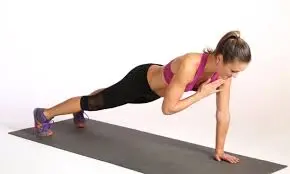
- Stabilization: Your body should remain in a straight line from your head to your heels as you hold the plank posture. As you balance on your hands, the brachioradialis supports your upper body weight by stabilizing your elbows and wrists.
- Anti-Rotation: Your body will automatically rotate to the side when you tap your shoulders alternately. Because it stabilises the arms and limits excessive movement at the elbow joint, the brachioradialis aids in the resistance against this rotational force.
The plank with shoulder taps is an exercise that primarily targets core stability and strength, but it also has the added benefit of working the brachioradialis and other arm muscles. It is a useful supplement to your exercise regimen since it increases the stability and strength of your upper body generally.
Push-ups with the finger tips:
An advanced kind of push-up, fingertip push-ups require you to support your body weight with your fingertips rather than your palms. Because this exercise requires more grip strength and wrist stability, it also significantly uses the brachioradialis muscle and other forearm muscles.
It is a useful exercise for developing the upper body and forearms since it works the muscles in the chest, shoulders, triceps, and forearms. However, to prevent wrist injuries, it’s crucial to advance cautiously and use the correct form.
To execute push-ups with the fingers:
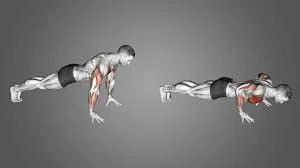
- Assume a plank position, with your body in a straight line from your head to your heels and your hands directly beneath your shoulders.
- Take a stance on your fingertips, with your fingers spread wide and your fingertips supporting your body weight, as opposed to laying your palms flat on the ground.
- Throughout the workout, keep your body upright and stable by using your core muscles. Avoid hunching over or arching your back, and maintain a hip-to-shoulder alignment.
- Bending your elbows to keep them close to your sides, lower your body towards the floor. Reduce the height of your chest till it is slightly over the floor, or as low as it is comfortable for you to go without compromising form.
- Let out a breath and use your elbows and fingertips to bring yourself back up to the starting position. Throughout the exercise, keep your body in a straight line and avoid sagging or elevating your hips.
- Continue performing the exercise for the required number of times, being sure to keep your muscles tense and your motions controlled.
- Activity caution is advised when performing fingertip push-ups, especially if you’re new to the activity, because it puts more strain on the wrists and forearms. As your strength increases, work your way up to more difficult varieties like incline fingertip push-ups before gradually moving on to full fingertip push-ups.
Crush your grip:
Start sitting and place the left wrist, palm up, on a good horizontal surface.
With a dumbbell in your left hand, spread and loosen your grip such that the weight rolls closer to your fingertips.
Squeeze the dumbbell back up as tightly as you can by curling your wrist and tightening your hand as soon as it hits your fingertips. One rep is awarded for this.
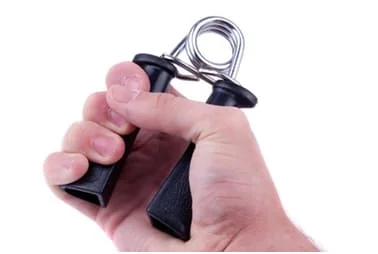
Repeat on the right side after completing the required number of reps.
Squeeze your forearm.
Start with a forearm grip.
Squeeze the forearm grip while extending and flexing your fingers.
Let go of the fingers after three to five seconds of holding.
Go on for ten to fifteen minutes. In this, there is just one set.
Crab walk:
Start by easing yourself into a tabletop inverse position.
Align the ankles directly under the knees and the hands directly under the shoulders, with the fingers pointing towards the feet.
Use your hands and feet to move ahead for a maximum of one minute. One rep is awarded for this.
Stretching exercise for brachioradialis:
Exercises that stretch the body are essential for preserving flexibility, enhancing mobility, and avoiding injuries. The following are some efficient stretches that target the brachioradialis muscle specifically:
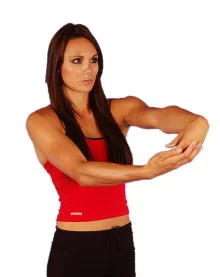
Brachioradialis stretch:
Raise your right arm straight and make a fist. Using the left hand, grasp the right fist.
Turn the right arm such that the thumb is clenched and facing the body.
Flex your right wrist gently with your left hand while maintaining a straight arm. This is the same motion used to bring the palm closer to the forearm during wrist curls.
Breathe normally while holding the stretch for 15 to 30 seconds, then switch to the other side.
Brachioradialis stretch while standing
Stretch your arms out in front of you while keeping your elbows firmly locked out.
Interlock your fingers after putting one hand over the other.
Bend the wrist of your lower hand.
Rotate your wrist to the left until a noticeable brachioradialis stretch is felt. Revolve your hands to the right and repeat with the other arm after holding it for ten to thirty seconds.
Brachioradialis stretch with arms down
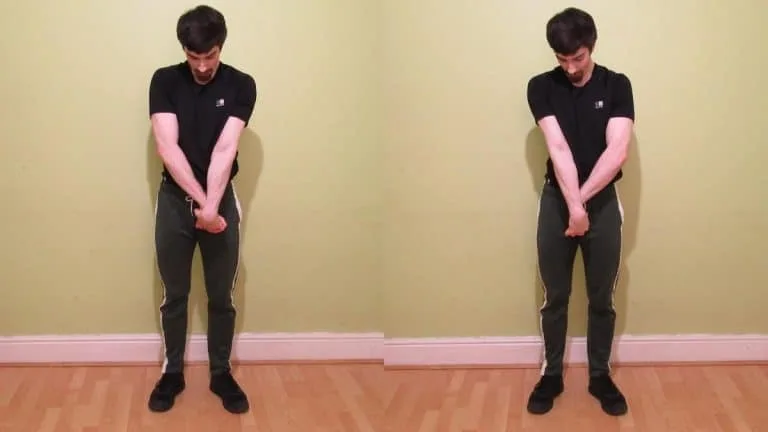
Place your wrists across each other and clasp your fingers together.
Next, keep your elbow locked out and rotate your upper wrist away from your body.
While you repeat each stretch with your opposite arm, try to hold it for ten to thirty seconds.
Brachioradialis stretch with arms extended back
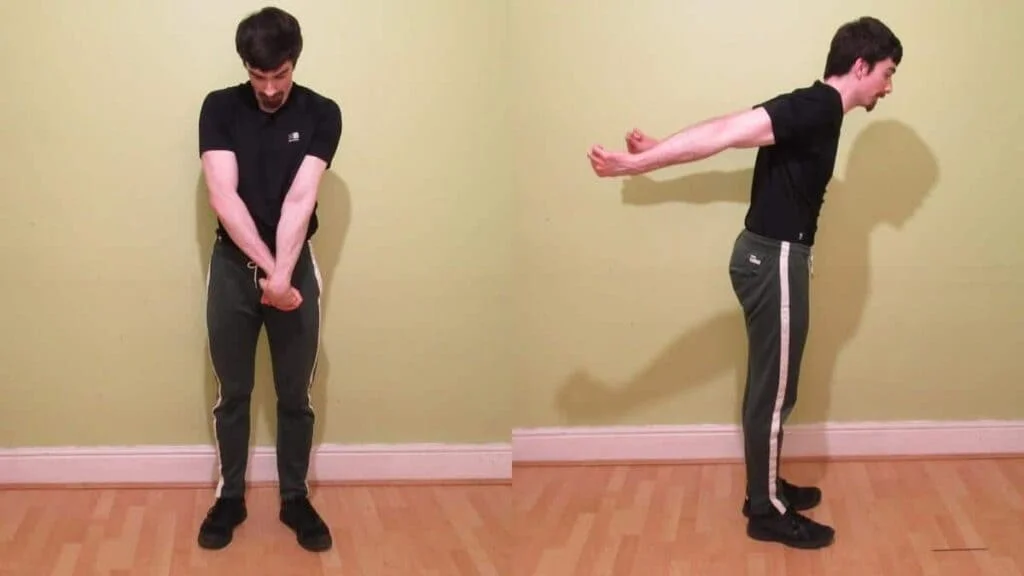
Maintain good posture and raise yourself up tall.
Pronate your hands by your sides, pointing your palms back.
Now, without bending your waist or moving your hips, extend your arms behind your body (as if you were rowing with straight arms) until you feel the deep brachioradialis stretch that I previously mentioned.
Do one or two additional sets after holding it for ten to thirty seconds.
Tips for stretching:
- After a thorough warm-up or at the conclusion of your workout, perform these stretches.
- Reach for the point of tension rather than soreness. There should be a slight tug, but not any pain.
- Inhale deeply, and focus on letting go of any tension in your muscles as you perform each stretch.
- After holding each stretch for 15 to 30 seconds, repeat each side two or three times.
- When stretching, try to avoid jumping or jerking movements, as this might cause harm.
- Stretching should be a frequent part of your regimen to keep your muscles loose and flexible.
Including These Workouts in Your Daily Routine
These are some exercises you may do as part of your normal training routine to help strengthen your brachioradialis. For every exercise, try to complete two to three sets of eight to twelve repetitions, varying the weight and intensity according on your level of fitness. To optimize the advantages and lower the danger of damage, it is imperative to concentrate on appropriate form and control.
Advantages of a Strong Brachioradialis
There are various advantages to brachioradialis strengthening:
Enhanced Grip Strength: Capable hands are essential for a variety of sports and everyday tasks like tugging, lifting, and transporting.
Injury Prevention: In sports where repetitive arm motions are a component of the activity, having strong forearm muscles helps to prevent injuries by supporting the wrists and elbows.
Balanced Arm Development: By emphasizing the brachioradialis, one can achieve balanced muscular growth in the arms, which enhances the overall strength and appearance of the arms.
Integrating Brachioradialis Training in an Exercise Program
A Balanced Approach
Arm strength and functionality can be improved with a well-rounded training programme that targets the brachioradialis and other forearm muscles. To guarantee thorough development, it’s critical to incorporate exercises that target the forearm flexors, extensors, and other supporting muscles.
Volume and Frequency
For most people, brachioradialis exercises can be beneficial twice or three times a week. For each exercise, aim for two to three sets of eight to twelve repetitions, making sure to give yourself enough rest time in between sessions. Depending on your fitness level and objectives, change the frequency and volume. As your strength increases, progressively increase the intensity.
Tracking Development
Effective training requires frequent progress tracking. To record the exercises done, the weights used, and any observations about form or discomfort, keep a workout notebook. Make necessary adjustments to your routine and strength periodically to keep pushing the brachioradialis and encouraging muscle growth.
Adaptability and Mobility
Forearm flexibility and mobility exercises, in addition to strength training, can improve general muscle function. After working out, stretching the forearm muscles can help keep them flexible and avoid getting tight. Mobility exercises can increase range of motion and guarantee that the brachioradialis and related muscles perform at their best.
Brachioradialis Exercise at Home
Easy Equipment
To train the brachioradialis efficiently, you don’t need a gym. For a variety of exercises that target this muscle, simple tools like dumbbells, resistance bands, and even everyday objects like water bottles can be utilized.
Exercises Using Your Bodyweight
Push-ups and pull-ups are examples of bodyweight workouts that are an excellent way to activate the brachioradialis. Forearm muscles can be targeted specifically by modifying these workouts to include other grips (e.g., neutral or reverse grips).
Consistency and Variation
Include a range of exercises that work the brachioradialis from various perspectives. Since consistency is essential, try to complete these exercises two to three times a week, paying attention to form, and stepping up the intensity as you gain strength.
Exercises for the Brachioradialis: Risks and Precautions
Possible Risks:
Overuse Injuries: Pain and swelling in the forearm and elbow can result from tendinitis and muscle strains caused by repetitive movements.
Incorrect Form: Inadequate technique can cause stress on the wrist and elbow joints, raising the possibility of imbalances in the muscles and injuries like tennis elbow.
Inadequate Warm-Up: Ignoring the warm-up can lead to pain and tightness in the muscles, as well as a higher chance of strains.
Excessive Load: Overtraining or excessive weightlifting can cause joint tension, persistent pain, and muscular exhaustion.
Inadequate Recovery: Skipping workouts too often can lead to chronic pain, diminished performance, and stunted muscular growth.
Preventive Actions:
Correct Cool-Down and Warm-Up: To prepare and heal your muscles, always begin with dynamic stretches and light cardio, and finish with static stretches.
Correct Form: To reduce the risk of injury and guarantee successful workouts, concentrate on keeping appropriate form.
Gradual Progression: In order to prevent overstressing muscles and joints, increase weights and intensity gradually.
Balanced Training: To avoid imbalances and increase general strength, incorporate workouts that work all of the forearm muscles.
Adequate Rest: Make sure you get enough food and water in between sessions, and give your muscles enough time to recuperate.
Listen to your body: Quickly address any pain or discomfort and discern between minor aches and pains and possible injuries.
People can develop improved overall arm strength and functioning, lower their risk of injury, and promote optimal forearm function by incorporating these exercises into a comprehensive fitness routine.
Conclusion
In conclusion, brachioradialis muscle exercise is critical for preserving forearm strength, enhancing grip performance, and promoting general arm health. Forearm pulls, dead hangs, wrist curls, reverse wrist curls, pull-ups, and other exercises can be used to target and strengthen the brachioradialis without the need for specialized equipment.
Stretching techniques such as pronation and supination stretches, as well as wrist flexor and extensor stretches, are also essential for preserving flexibility and avoiding injuries in the brachioradialis and adjacent muscles. A good brachioradialis workout program must include appropriate form, consistent and balanced training, and enough rest and recuperation.
FAQs
What is the muscle known as the brachioradialis?
On the lateral side of the forearm lies a muscle called the brachioradialis. It penetrates into the distal radius after emerging from the lateral supracondylar ridge of the humerus.
How does the brachioradialis muscle function?
At the elbow joint, the brachioradialis muscle flexes the forearm. It facilitates the flexion of the forearm during supination or when the forearm is being used for activities like hammering or pronating.
How can I exercise at home to strengthen my brachioradialis muscle?
A number of exercises, such as chin-ups, pull-ups, wrist curls, reverse wrist curls, dead hangs, and forearm pulls, can be performed at home to develop the brachioradialis muscle. These exercises, which focus on the brachioradialis, require little to no equipment to perform.
Is there a particular brachioradialis muscle stretch?
Indeed, there are a few stretches that work on the brachioradialis muscle and increase the range of motion in the forearm. These consist of pronation and supination stretches, forearm flexor and extensor stretches, and wrist flexor and extensor stretches.
How frequently should I work out the brachioradialis muscle?
The brachioradialis muscle should be worked out two to three times a week, with enough time for rest and healing in between. Making progress and preventing overuse problems require consistency.
Is it possible to prevent injuries by strengthening the brachioradialis muscle?
Absolutely, by increasing forearm strength and stability, brachioradialis muscle training can aid in the prevention of accidents. When engaging in physical activity, a robust brachioradialis muscle supports the elbow and wrist joints, lowering the chance of strains and overuse problems.
Should I exercise the brachioradialis muscle with any safety precautions?
To prevent injury, it’s crucial to perform brachioradialis exercises with the right form and technique. As your strength increases, start with lighter weights and progressively increase the intensity. If you feel pain or discomfort during exercising, pay attention to your body and stop.
Can brachioradialis muscles benefit from stretching exercises?
Indeed, brachioradialis muscles benefit from stretching workouts since they increase muscle flexibility and decrease muscle tension. Stretching keeps the forearm joints in their ideal range of motion and helps avoid stiffness, which can result in injuries when engaging in physical activity.
For what duration should I hold brachioradialis muscle stretches?
When performing brachioradialis muscle stretches, hold the poses for 15–30 seconds to give the muscles time to lengthen and rest. For optimal effect, repeat each stretch two to three times on each side.
Is it possible to include brachioradialis workouts in my normal fitness regimen?
Absolutely, you can include brachioradialis exercises in your normal training regimen to increase the strength and functionality of your forearms. These exercises help strengthen the arms generally and can be used in conjunction with other upper body workouts.
Are there any brachioradialis muscle exercises that don’t require the use of equipment?
Yes, there are a number of equipment-free exercises that work the brachioradialis muscle well. These exercises include dynamic motions like arm circles and wrist rotations, as well as bodyweight exercises like push-ups, pull-ups, and dead hangs.
Are there any particular brachioradialis workouts that are advised for sports enthusiasts or athletes?
Exercises for the brachioradialis muscle can help athletes and sports lovers enhance their forearm strength, grip efficiency, and general athletic performance. Brachioradialis strength and endurance can be developed by exercises like farmer’s walks, rope climbs, chin-ups, and kettlebell swings. This can improve performance in sports like weightlifting, tennis, golf, martial arts, and climbing. It’s critical to adjust workout selection and intensity to meet the demands of a certain sport as well as personal training objectives.
Reference:
- Cronkleton, E. (2023, May 31). 13 Forearm Exercises to Do at the Gym or at Home. Healthline. https://www.healthline.com/health/forearm-exercises
- Aliens, A. (2020, December 9). 7 Intense Brachioradialis Exercises | How To Build Bigger Forearms! Anabolic Aliens. https://anabolicaliens.com/blogs/the-signal/7-intense-brachioradialis-exercises
- Cscs, J. C. M., & Cscs, J. C. M. (2024, February 16). Forearm Workouts. ATHLEAN-X. https://athleanx.com/articles/forearm-workouts
- Rees, M. (2022, August 31). What are some of the best forearm exercises to try? https://www.medicalnewstoday.com/articles/forearm-exercises
- B. (2023, July 20). The 5 Best Exercises to Increase Forearm Size and Strength. Built with science. https://builtwithscience.com/fitness-tips/forearm-exercises/
- Romine, S. (2020, April 23). Are You Working Your Forearms? Because you should be. Greatist. https://greatist.com/health/forearm-exercises
- Ladva, V. (2022, March 26). Brachioradialis Muscle Pain: Cause, symptoms, Treatment, Exercise. Samarpan Physiotherapy Clinic. https://samarpanphysioclinic.com/brachioradialis-muscle-pain/
- Thakkar, D. (2023, March 25). Brachioradialis Muscle – Origin, Insertion, Function, Exercise. Samarpan Physiotherapy Clinic. https://samarpanphysioclinic.com/brachioradialis-muscle/
- V. (2023, October 29). Brachioradialis muscle. Mobility Physiotherapy Clinic. https://mobilephysiotherapyclinic.net/brachioradialis-muscle/#1_Resisted_band_supination
- Bamaniya, V. (2024, April 1). Brachioradialis Muscle – Origin, Insertion, Function. Physical Therapy Treatment and Exercise. https://physical-therapy.us/brachioradialis-muscle/

